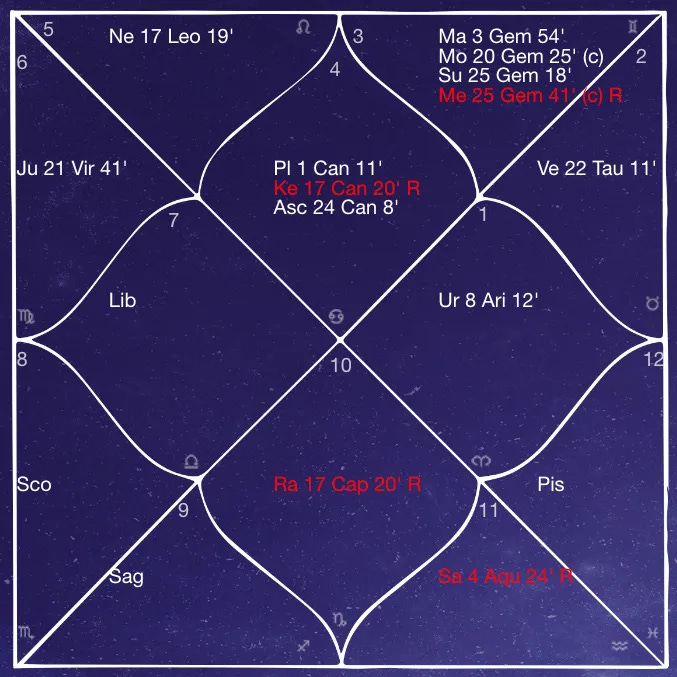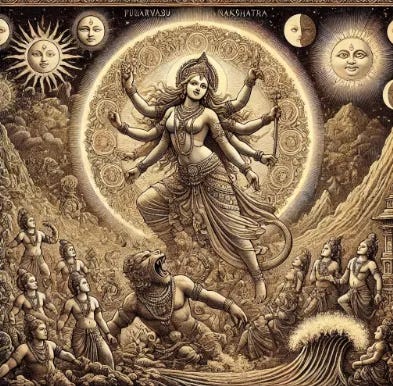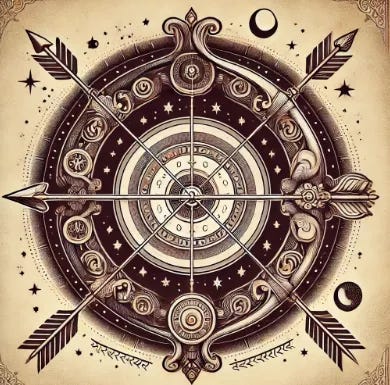Punarvasu Nakshatra, the seventh in the lunar constellation series, radiates an energy of renewal and resilience. It embodies a nurturing force that supports growth and regeneration, reminding us of life’s enduring cycles and the ever-present promise of new beginnings.
Before we begin, I recommend reading my first two posts on the topic before continuing with this one.
The Basics

Punarvasu Nakshatra straddles the zodiac signs of Gemini and Cancer, spanning from 20°00' Gemini to 3°20' Cancer (sidereal). As the 7th nakshatra in the lunar sequence, it is renowned for its revitalizing energy. The name "Punarvasu" translates to "return of the light" or "renewal," symbolizing rejuvenation, hope, and fresh starts.
The Myth
The mythology of Punarvasu centers on Aditi, the mother of the gods. Aditi is revered as the primordial goddess of the sky and earth, embodying the boundless, infinite nature of the cosmos. She gave birth to the twelve Adityas (solar deities), who represent the months of the year. As a cosmic mother, Aditi represents the forces of nurturing, sustenance, and continuity.
Aditi's journey, however, was not without hardship. When her sons, the Devas, were overpowered by demonic forces (asuras), she undertook intense penance. Her devotion bore fruit with the birth of Vamana, an incarnation of Vishnu, who restored cosmic balance.
This myth captures the essence of Punarvasu: the eternal cycle of creation, loss, and regeneration. It is a reminder of the light that inevitably follows darkness, the resilience required to endure trials, and the hope embedded in new beginnings.
Symbolism
The primary symbol of Punarvasu is the bow and a quiver of arrows. The bow signifies direction and focus; the arrows represent potential and the will to realize one's goals.
The presiding deity, Aditi, embodies protection, maternal strength, and the power to initiate new cycles. Her presence infuses this nakshatra with creative life force and expansive possibility.
From the myth and symbolism, we gather key themes:
Aditi's resilience and nurturing spirit — protection, motherhood, and rebirth
The bow and quiver — focus, intention, and achievement
The idea of renewal — the cycle of dissolution and new creation
Rulerships
Understanding the planetary and sign rulerships adds more dimension to Punarvasu:
Nakshatra Ruler: Jupiter, the planet of wisdom, benevolence, and expansion. Jupiter's influence gives this nakshatra optimism, ethical clarity, and spiritual insight.
Zodiac Sign Influence:
Gemini (ruled by Mercury): Brings intellectual curiosity, adaptability, and communicative flair.
Cancer (ruled by the Moon): Adds emotional depth, nurturing tendencies, and intuitive sensitivity.
Putting It All Together
Let’s synthesize the key elements of Punarvasu:
Name: "Punarvasu" — renewal, return of the light
Deity: Aditi — motherhood, continuity, resilience
Symbol: Bow and quiver — focus, potential, purposeful action
Ruler: Jupiter — wisdom, morality, growth
In Gemini: Intellect, communication, duality
In Cancer: Emotional wisdom, protection, nurturing
What It Means to Have the Moon in Punarvasu

Those with their Moon in Punarvasu often radiate optimism and inner strength. They tend to recover from setbacks with grace and a renewed spirit. Naturally nurturing, these individuals often feel a strong moral compass and a desire to support others.
They are thoughtful communicators with sharp intellects, often possessing an eloquent or persuasive way with words. Emotionally, they crave stability and emotional safety, and they often prioritize their families and close relationships. Whether the Moon falls in Gemini or Cancer shades these qualities: Gemini lends a more cerebral and articulate bent, while Cancer brings out emotional richness and care.
A Quick Example

Here is a chart with the Moon in Punarvasu, located in Gemini in the 12th house. Interestingly, the Sun and Mercury are also closely conjoined in Punarvasu.
Key observations:
Four prominent planets in the 12th house indicate a private, possibly introspective person with a strong pull toward isolation or spiritual retreat.
The Gemini influence suggests duality in their outward persona — perhaps leading a 'double life' or hiding aspects of themselves.
With multiple planets in Punarvasu, this person likely faced adversity but had the resilience to rise above it.
The abundance of Gemini energy also points to heightened curiosity, intellect, and communication ability.
Mars, the 5th house ruler, is also placed in the 12th house, suggesting a private but rich creative life, possibly with multiple artistic or expressive talents.
This example illustrates how the placement of Punarvasu can speak volumes about a person’s inner world, resilience, and capacity for renewal.
Conclusion
Punarvasu reminds us that no matter how dark or difficult things may become, light always returns. It’s a nakshatra of healing and restoration, of quiet strength and thoughtful growth. Punarvasu offers a beautiful lens through which to explore the cyclical nature of life—and our capacity to begin again.
References
The Nakshatras: The Stars Beyond the Zodiac by Komilla Sutton
The Nakshatras by Dennis Harness
The Essentials of Vedic Astrology by Komilla Sutton
Nakshatra — The Authentic Heart of Vedic Astrology by Vic DiCara
27 Stars, 27 Gods: The Astrological Mythology of Ancient India by Vic DiCara
Vedic Astrology Simply Put by William R. Levacy







